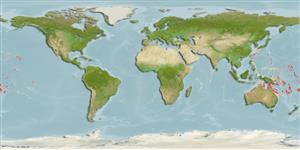>
Ovalentaria/misc (Various families in series Ovalentaria) >
Pomacentridae (Damselfishes) > Pomacentrinae
Etymology: Amphiprion: Greek, amphi = on both sides + Greek, prion, -onos = saw (Ref. 45335); pacificus: Named for its Pacific Ocean distribution.
Environment: milieu / climate zone / depth range / distribution range
Ekologi
laut berasosiasi dengan karang; kisaran kedalaman 4 - 10 m (Ref. 85065). Tropical
Pacific: Wallis Island, Tonga, Fiji and American Samoa.
Size / Weight / umur
Maturity: Lm ? range ? - ? cm
Max length : 4.8 cm SL jantan/; (Ref. 85065)
deskripsi pendek
Kunci identifiaksi (pengenalan) | Morfologi | Morfometrik
Duri punggung (Keseluruhan (total)) : 9; duri punggung lunak (Keseluruhan (total)) : 18 - 20; Duri dubur: 2; Sirip dubur lunak: 12 - 13. This species is distinguished by the following set of characters: D IX,18-20; A II,12-13; pectoral rays 17-18; tubed lateral line scales 33-48; gill rakers 5-6 + 11-12; opercular spinules 8-11; body depth 2.2-2.6 in SL; color generally pinkish brown, usually grading to yellowish or orange on lower side of body including abdomen; white stripe on midline of snout extending posteriorly on forehead and along base of dorsal fin; fins whitish to semi-translucent (Ref. 85605).
This species is generally commensal with the anemone Heteractis magnificus (Quoy & Gaimard, 1833) at depths between about 4-10 m (Ref. 85065). Oviparous, distinct pairing during breeding (Ref. 205). Eggs are demersal and adhere to the substrate (Ref. 205). Males guard and aerate the eggs (Ref. 205).
Life cycle and mating behavior
Kematangan | Reproduksi, perkembang biakan | Pemijahan | telur-telur | Fecundity | Larva
Oviparous, distinct pairing during breeding (Ref. 205). Eggs are demersal and adhere to the substrate (Ref. 205). Males guard and aerate the eggs (Ref. 205).
Allen, G.R., J. Drew and D. Fenner, 2010. Amphiprion pacificus, a new species of anemonefish (Pomacentridae) from Fiji, Tonga, Samoa, and Wallis Island. aqua, Int. J. Ichthyol. 16(3):129-138. (Ref. 85065)
Status IUCN Red List (Ref. 130435: Version 2024-1)
ancaman kepada manusia
Harmless
penggunaan manusia
Alat, peralatan
laporan khas
muat turun XML
Sumber internet
Estimates based on models
Preferred temperature (Ref.
123201): 25.2 - 29.4, mean 27.6 °C (based on 704 cells).
Phylogenetic diversity index (Ref.
82804): PD
50 = 0.5000 [Uniqueness, from 0.5 = low to 2.0 = high].
Bayesian length-weight: a=0.01479 (0.00651 - 0.03363), b=3.00 (2.81 - 3.19), in cm total length, based on LWR estimates for this (Sub)family-body shape (Ref.
93245).
Trophic level (Ref.
69278): 2.8 ±0.3 se; based on size and trophs of closest relatives
Daya lenting (Ref.
120179): Tinggi, Waktu penggandaan populasi minimum kurang dari 15 bulan (Preliminary K or Fecundity.).
Fishing Vulnerability (Ref.
59153): Low vulnerability (10 of 100).
